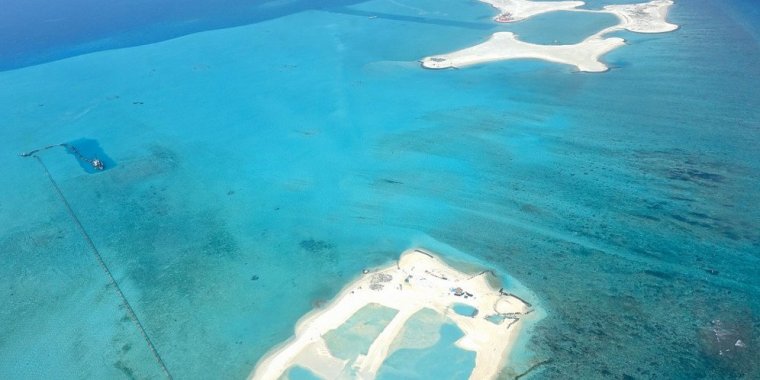| News / World News |
Maldives’ man-made islands offer answer to sea-level rise
Raising the heights of islands and building completely new ones are among solutions to climate change-related sea-level rise for the Maldives and other low-lying, small island developing states, scientists say in a new study.

Artificial islands being constructed in Kaafu Atoll. A new study says islands need to be raised by six metres or more to protect Maldives. Photo: Luka Peternel
According to the 6th Assessment Report of the Intergovernmental Panel on Climate Change (IPCC), by mid-century one billion people will be exposed to much greater risks of flooding due to sea level rise and face storm surges, increased tidal flooding or even permanent submergence.
Maldives, picked for the study, has already built the new island of Hulhumalé using sand dredged up from the sea and is planning to build new islands to accommodate the needs of rapid urbanisation and its tourism industry.
The South Asian island nation is considered particularly vulnerable since more than 80 per cent of its land, on 1,000 plus islands, is less than one metre above sea level.
The researchers say that for long-term protection Maldives will need to raise the height of its islands to six metres or more above sea level.
“Of course, these islands would look very different to the beautiful ones with beaches we see in tourist brochures. They would be very urban with many high-rise buildings, as seen in [the capital] Malé today,” a press release from the University of East Anglia said.
The building-new-islands-higher concept has implications for other low-lying island nations such as Kiribati, Tuvalu, and the Marshall Islands, the release added.
“What we are suggesting is scaling up existing activity, not doing something completely new,” says Robert Nicholls, director of the Tyndall Centre for Climate Change Research at the University of East Anglia in the UK and one of the authors of the paper. “This approach shows there is another adaptation approach available.”
“Land reclamation following the approaches we suggest is widespread in the Maldives today and the new island of Hulhumalé, built next to the capital island of Male and linked by a new bridge, was raised about one metre above natural island elevation as an adaptation to marine hazards – sea-level rise and also tsunami.”
However, raising island heights or building new ones can be costly. Michael Oppenheimer, professor of Geosciences and International Affairs at Princeton University believes the costs of creating artificial islands will probably be prohibitive and says there are “obvious, negative environmental impacts”.
Nicholls admits that there are costs to creating new islands and raising heights. “But, that is true for any adaptation intervention. So those conducting the adaptation need to assess the trade-offs,” he says.
In terms of applying the approach, he says the main resource needed is sand, which is readily available in the Maldives. “The environmental implications would need to be assessed but these sand resources are already being exploited.”
He estimates that the sand costs US$8 per cubic metre, which translates to about US$8 million to raise a square kilometre of land by one metre. “These reclamations were funded by the Maldivian government and the sand was sourced and delivered via dredging,” he explained.
The approach suggested in the study, he says, would be most effective with the slowest sea-level rise associated with strong climate stabilisation.
According to Nicholls, raising islands makes the islanders safer from tsunamis as well as sea-level rise. “So this approach addresses both hazards to some degree.”
At a meeting of the UN Security Council earlier this month, UN Secretary-General Antonio Guterres said that climate change-induced sea-level rise is a direct threat to millions around the world and warned that the world could witness “a mass exodus of entire populations on a biblical scale”. (SciDev.Net)
YOU MAY ALSO LIKE





